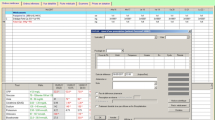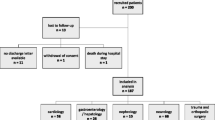Abstract
OBJECTIVE
To determine the overdose rate of drugs that require renal dose adjustment and factors related with overdose.
SUBJECTS
Total of 23,635,210 records of prescriptions and laboratory data of inpatients at a tertiary teaching hospital for the period from January 2002 to December 2005.
METHODS
A clinical data mart was constructed. A knowledge base containing dose adjusting information about 56 drugs was built. One day dose was compared to the reference dose adjusted to the patient’s renal function.
RESULTS
Considering the patient’s renal function, 5.3% of drug doses were excessive. The overdose rate in the patients with moderate to severe renal insufficiency was 28.2%. Only 25% of physicians were responsible for 50.6% of the overdoses. Of 56 drugs studied, 10 drugs, including ranitidine, amoxicillin, and piperacillin/tazobactam, were involved in 85.4% of the overdoses. The physicians with high overdose rate had patients with more impaired renal function (correlation coefficient = 0.192, P < .001). There were negative correlation between clinical experiences of physician and overdose rate (correlation coefficient = −0.221, P < .001) and workload of prescription (correlation coefficient = −0.446, P < .001), when excluding interns from the analyses. There was positive correlation between workload of prescription and overdose rate (correlation coefficient = 0.361, P < .001).
CONCLUSION
A clinical data mart was useful to analyze the vast amount of electronic hospital data. Drug overdose is quite common among inpatients with renal insufficiency. Only a few drugs are responsible for most of drug overdoses. The physicians’ clinical experience, workload of prescriptions, and patients’ renal function are correlated with drug overdose.



Similar content being viewed by others
References
Kohn LT, Corrigan J, Donaldson MS. To err is human: building a safer health system. Washington, DC: National Academy Press; 2000.
Bobb A, Gleason K, Husch M, Feinglass J, Yarnold PR, Noskin GA. The epidemiology of prescribing errors: the potential impact of computerized prescriber order entry. Arch Intern Med. 2004;164:785–92.
Lam YW, Banerji S, Hatfield C, Talbert RL. Principles of drug administration in renal insufficiency. Clin Pharmacokinet. 1997;32:30–57.
Talbert RL. Drug dosing in renal insufficiency. J Clin Pharmacol. 1994;34:99–110.
Matzke GR, Frye RF. Drug administration in patients with renal insufficiency. Minimising renal and extrarenal toxicity. Drug Saf. 1997;16:205–31.
Muhlberg W, Platt D. Age-dependent changes of the kidneys: pharmacological implications. Gerontology. 1999;45:243–53.
Kappel J, Calissi P. Nephrology: 3. Safe drug prescribing for patients with renal insufficiency. CMAJ. 2002;166:473–7.
Chertow GM, Lee J, Kuperman GJ, et al. Guided medication dosing for inpatients with renal insufficiency. JAMA. 2001;286:2839–44.
Falconnier AD, Haefeli WE, Schoenenberger RA, Surber C, Martin-Facklam M. Drug dosage in patients with renal failure optimized by immediate concurrent feedback. J Gen Intern Med. 2001;16:369–75.
Renal Dosing Database. Available at http://www.globalrph.com/index_renal.htm. Accessed May 24, 2007.
Gilbert DN, Moellering RC, Eliopoulos GM, Sande MA. The Sanford Guide to Antimicrobial Therapy, 34th ed. Virginia: Antimicrobial Therapy; 2004.
Levey AS, Bosch JP, Lewis JB, Greene T, Rogers N, Roth D. A more accurate method to estimate glomerular filtration rate from serum creatinine: a new prediction equation. Modification of Diet in Renal Disease Study Group. Ann Intern Med. 1999;130:461–70.
Garg DC, Baltodano N, Jallad NS, et al. Pharmacokinetics of ranitidine in patients with renal failure. J Clin Pharmacol. 1986;26:286–91.
Slugg PH, Haug MT 3rd, Pippenger CE. Ranitidine pharmacokinetics and adverse central nervous system reactions. Arch Intern Med. 1992;152:2325–29.
Garg AX, Adhikari NK, McDonald H, et al. Effects of computerized clinical decision support systems on practitioner performance and patient outcomes: a systematic review. JAMA. 2005;293:1223–38.
Kaushal R, Shojania KG, Bates DW. Effects of computerized physician order entry and clinical decision support systems on medication safety: a systematic review. Arch Intern Med. 2003;163:1409–16.
Glassman PA, Simon B, Belperio P, Lanto A. Improving recognition of drug interactions: benefits and barriers to using automated drug alerts. Med Care. 2002;40:1161–71.
Galanter WL, Didomenico RJ, Polikaitis A. A trial of automated decision support alerts for contraindicated medications using computerized physician order entry. J Am Med Inform Assoc. 2005;12:269–74.
van der Sijs H, Aarts J, Vulto A, Berg M. Overriding of drug safety alerts in computerized physician order entry. J Am Med Inform Assoc. 2006;13:138–47.
Shah NR, Seger AC, Seger DL, et al. Improving acceptance of computerized prescribing alerts in ambulatory care. J Am Med Inform Assoc. 2006;13:5–11.
Soumerai SB, McLaughlin TJ, Avorn J. Improving drug prescribing in primary care: a critical analysis of the experimental literature. Milbank Q. 1989;67:268–317.
Davis DA, Thomson MA, Oxman AD, Haynes RB. Changing physician performance. A systematic review of the effect of continuing medical education strategies. JAMA. 1995;274:700–5.
Acknowledgements
The authors would like to acknowledge Dr. Hyuck Joon Chung for his assistance in the reference knowledge base review. This study was supported by a grant from the Korea Health 21 R&D project, Ministry of Health &Welfare, Republic of Korea (A050571); by a grant from the Korea Research Foundation, Republic of Korea (KRF-2006-332-E00093); and by a grant from the Department of Medical Sciences, The Graduate School, Ajou University.
Conflicts of Interest
None disclosed.
Author information
Authors and Affiliations
Corresponding author
Additional information
First two authors are equally contributed to this work.
Rights and permissions
About this article
Cite this article
Sheen, S.S., Choi, J.E., Park, R.W. et al. Overdose Rate of Drugs Requiring Renal Dose Adjustment: Data Analysis of 4 Years Prescriptions at a Tertiary Teaching Hospital. J GEN INTERN MED 23, 423–428 (2008). https://doi.org/10.1007/s11606-007-0336-8
Published:
Issue Date:
DOI: https://doi.org/10.1007/s11606-007-0336-8




